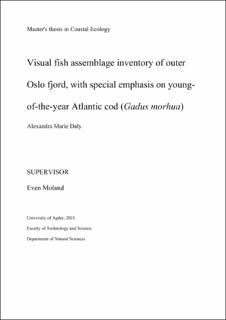| dc.contributor.author | Daly, Alexandra Marie | |
| dc.date.accessioned | 2021-09-17T12:37:51Z | |
| dc.date.available | 2021-09-17T12:37:51Z | |
| dc.date.issued | 2021 | |
| dc.identifier.citation | Daly, A.M. (2021) Visual fish assemblage inventory of outer Oslo fjord, with special emphasis on young-of-the-year Atlantic cod (Gadus morhua) (Master's thesis). University of Agder, Kristiansand. | en_US |
| dc.identifier.uri | https://hdl.handle.net/11250/2778930 | |
| dc.description | Master's thesis in Coastal ecology (BIO501) | en_US |
| dc.description.abstract | The coastal zone along the outer Oslofjord is physically unique and home to many ecologically depleted and economically important species, including Atlantic cod (Gadus morhua). Coastal cod in Skagerrak is divided into two ecotypes that co-exist in outer Oslofjord. Remnant local populations are considered sensitive to climate disturbances and anthropogenic influences. Recruitment of cod in Skagerrak is monitored in the annual beach seine sampling. A strong year-class of cod recruited to nursery areas in outer Oslo fjord in 2017. Although recruitment of cod has been monitored extensively in Skagerrak, studies have only recently begun to examine the recruitment phase of Atlantic cod, the factors that confer success or failure post settlement, and how recruitment plays a role in the overall health and survival of the population. One method increasingly used to examine fish populations is Baited Remote Underwater Video (BRUV). Studies using visual sampling techniques enable scientists to take a closer and less invasive look, while video recording of observations means that data might be shared and validated objectively. The aims of this study were to gather baseline biological data, capture information on the fish assemblage present in the fjord habitats at the time of sampling, scope for features of habitat and substrate that is conducive to harboring young-of-the-year Atlantic cod and determine factors with explanatory properties regarding occurrence and co-occurrence of cod recruits and juveniles of other species. A BRUV study was conducted in August 2017 and the data derived from the video in the purpose built software Event Measure. Based on analyses of the data thus obtained, Gadidae was found to be the most abundant family with cod being the most abundant species in that family. Cod presence and counts (abundance) seemed to have an impact on the fish diversity of the area, and it was found that shallow depths and sandy habitats were the strongest drivers in determining cod presence at sampled stations. | en_US |
| dc.language.iso | eng | en_US |
| dc.publisher | University of Agder | en_US |
| dc.rights | Attribution-NonCommercial-NoDerivatives 4.0 Internasjonal | * |
| dc.rights.uri | http://creativecommons.org/licenses/by-nc-nd/4.0/deed.no | * |
| dc.subject | BIO501 | en_US |
| dc.title | Visual fish assemblage inventory of outer Oslo fjord, with special emphasis on young-of-the-year Atlantic cod (Gadus morhua) | en_US |
| dc.type | Master thesis | en_US |
| dc.rights.holder | © 2021 Alexandra Marie Daly | en_US |
| dc.subject.nsi | VDP::Matematikk og Naturvitenskap: 400::Zoologiske og botaniske fag: 480::Marinbiologi: 497 | en_US |
| dc.source.issue | 94 | en_US |

